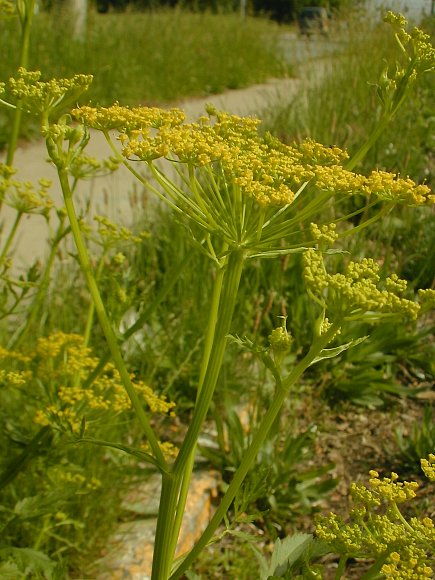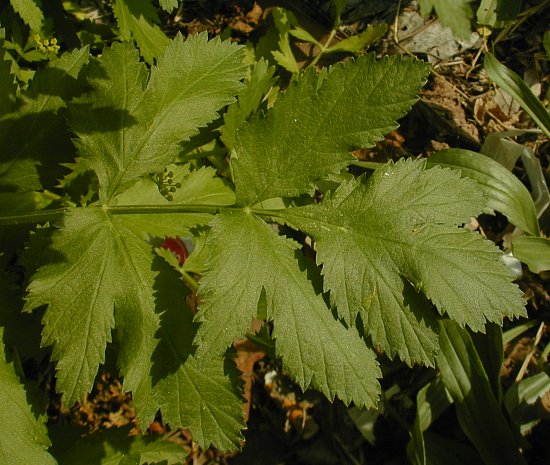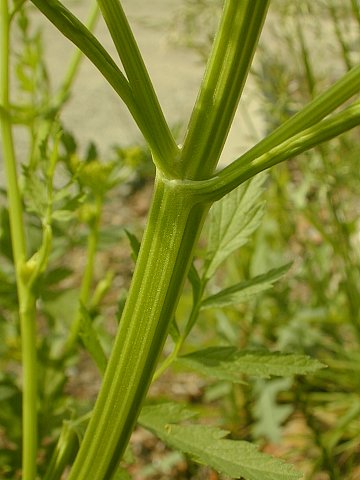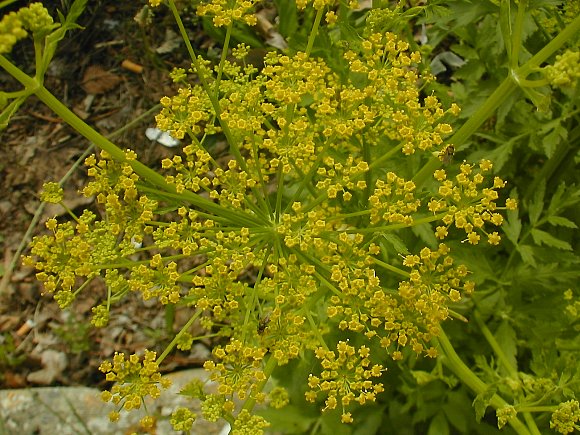Description: This herbaceous biennial plant is 2-5' tall, branching occasionally. The stems are glabrous, angular, and furrowed. The alternate leaves are oddly pinnate, consisting of about 9 leaflets that are largely hairless. The lower compound leaves are up to 18" long and 6" across; they have long petioles. The upper compound leaves are substantially smaller; they have short petioles. The individual leaflets are up to 3" long, 2" across, and ovate or elliptic in outline; they often have cleft lobes and coarse teeth along the margins.

The upper stems terminate in compound umbels of tiny yellow flowers. Each compound umbel has a long naked peduncle and spans about 3-8" across when fully mature; it is flat-topped. A compound umbel consists of about 15-25 umbellets, and each umbellet has about 12-35 flowers. Both floral bracts and floral bractlets are absent. Each flower is about 1/8" across, consisting of 5 yellow petals, a greenish yellow nectar pad, and insignificant sepals. The tiny petals are initially folded toward each other, but they eventually curve outward. The blooming period typically occurs from late spring to mid-summer and lasts about 1-2 months; a few plants may bloom later in the year. Each flower is replaced by a schizocarp containing a single seed. The seeds are flattened and winged; they are blown about by the wind. The root system consists of a stout fleshy taproot with a distinctive aroma that is quite similar to cultivated parsnips. This plant spreads by reseeding itself.

Cultivation:
The
preference is full or partial sun, moist to mesic conditions, and
fertile loamy soil. This adaptable plant also tolerates other kinds of
soil. After blooming and setting fruit, the foliage of Wild Parsnip
turns yellow and withers away.
Range & Habitat:
The non-native Wild Parsnip is a common plant that occurs in every
county of Illinois
(see Distribution
Map). It is relatively more common in central and northern
Illinois than southern Illinois. Habitats include moist to mesic black
soil prairies, savannas, pastures and fields, weedy meadows, areas
along railroads and roadsides, vacant lots, and waste areas. Wild
Parsnip can invade natural areas, especially prairies and savannas with
fertile soil. It is native to Europe.

Faunal Associations: The nectar of the flowers attracts such common visitors as flies, wasps, beetles, and ants. Wasp visitors include Crabronid wasps, bee wolves, Spider wasps, Vespid wasps, Eumenid wasps, Velvet ants, Cuckoo wasps, Chalcid wasps, Ichneumonid wasps, and Braconid wasps. Less common visitors include short-tongued bees, butterflies, and plant bugs. The caterpillars of the butterfly Papilio polyxenes asterias (Black Swallowtail) feed on the foliage. The foliage of Wild Parsnip is toxic and irritating in the presence of sunlight, particularly when it is in bloom. This is the result of the foliage releasing singleton oxygen, which is chemically highly reactive (to an even greater extent than triplet oxygen, or ozone). Thus, the foliage in this condition can irritate the digestive tracts of herbivores and raise blisters on the skin of humans. The taproots of 1st year plants are edible during the fall.

Photographic
Location:
A vacant lot in Urbana, Illinois.
Comments:
This is the wild form of the cultivated vegetable of the same name.
Wild Parsnip can be distinguished from other members of the Carrot
family by considering the following characteristics: 1) It has
flat-topped compound umbels of yellow flowers, 2) it has compound
leaves that are single pinnate, rather than double pinnate, and 3)
there are more than 8 teeth on each side of a leaflet
(excluding leaflets of smaller leaves).